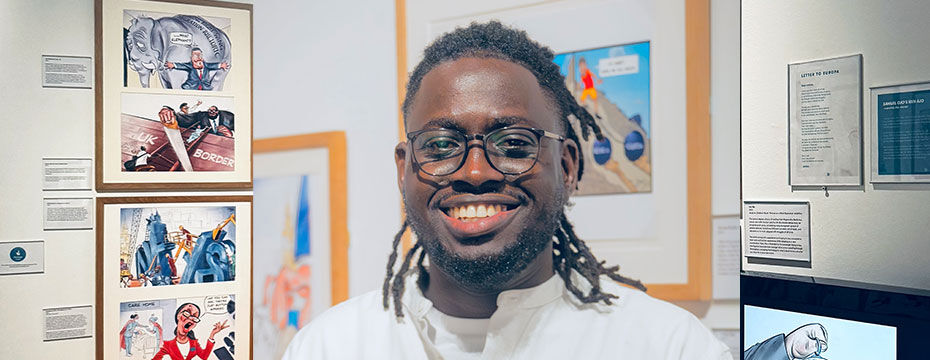University News Last updated 10 November

Samuel Ojo, who graduated with a postgraduate degree in Visual Communication in 2024, recently scored the exciting new role.
The graduate’s journey from Nigeria to study in Birmingham was a huge transition for him.
He said: “My time at BCU was a mixture of good and bad. I came as an international student, and I came with a lot of hope. I’m from Nigeria, so the culture shock was huge.
“There were several students in our group, but I was the only one from Nigeria. In England, there were norms of how to approach a brief and in Nigeria it was different.”
Samuel explained that he had to come into his new environment and unlearn a lot of what he had known previously. Essentially, re-learning how to approach situations to adapt and be successful.
He said: “My lecturers were so helpful with that. It did slow me down and then I caught onto the groove towards the tail end of the second semester. I did question myself often: ‘Did I come to the right course?’ or ‘What am I doing wrong?’. But eventually, I was able to find real joy in the course, and it was smooth sailing from there.”
The alumnus decided to do a degree in Visual Communication because it encompassed multiple disciplines. His class had a variety of artists such as illustrators, photographers and graphic designers. His most notable project would be Ìrìn Àjò, that was eventually turned into an exhibition at the Cartoon Museum in London.
He explained: "As I mentioned, it was difficult for my wife and I to transition to Birmingham. My wife is a writer, and in our frustrations, she penned this beautiful poem about what we were going through. After reading it, I thought I could draw something to accompany the poem. Then, I shared it in class and with my tutors.”
“It was then picked up to be exhibited and that’s how the project went from my wife and I to something others could relate to. Ìrìn Àjò set the tone for my practise in the UK.”
Samuel admits that he never thought he was going to be an illustrator. From theatre to graphic design, he set his sights on designing and motion design. Then things suddenly changed when he got commissioned in 2016.
He said: “I got a request to design a political cartoon about Donald Trump. I told him that I was not a political cartoonist, but the person requesting it had worked with me before, so they really trusted me. That project was one of the hardest I’ve ever done in my life because it wasn’t my forte. But he loved it and suggested I make political cartooning my career.”
The graduate eventually halted his previous design endeavours to concentrate on political cartooning. It also gave him an outlet to bring to light political issues happening in Nigeria. Though he didn’t think that political cartooning would be in his future, he remembered admiring comics and drawings in newspapers that his father collected and archived.

He said: “I would describe my career as serendipitous. I say that because with my love of theatre to graphic design then to being a political catalyst is not a trajectory I have seen elsewhere. Sometimes when I think about it, I wonder how I went from here to here.”
As a volunteer at the Cartoon Museum in London, Samuel explains the journey to defining his own style and studying the greats.
“Different cartoonists have different styles and when you’re in the industry you can tell everyone’s style apart. I am still on a path where I develop my own style. I don’t think I have found it yet, I’m still quite inspired and a big student of the greats.”
His new accomplishment of working with The Guardian newspaper came about through doors that BCU opened. The alumnus would often send cold emails to company’s he admired the most.
He said: “One thing I picked up in school by my course leader Rob Gibb was ‘don’t wait to send something’ and he encouraged us to just go for it.”
“I sent a message to Ella Baron about one of her upcoming exhibitions. I ended up going and meeting an editor for The Guardian who wanted to see my work and suggested I submit it. It’s been a fun experience for me because now I draw more and I am published alongside my favourite cartoonists.”
“In the future, I look forward to having an Ìrìn Àjò 2.0 and get in touch with more galleries and museums to share it. As well, I’d love to open a gallery similar to the Cartoon Museum in Nigeria. My wife and I want to create a children’s book that talks about immigration from a child’s perspective. We want to talk about immigrant children and their experience with going to school and having to adapt.”
Samuel also has advice to those following in his footsteps: “The creative industries reward authenticity and persistence, never wait for anybody’s validation.
“Be open to volunteering and collaborating, network with everyone you can and stay true to your story because that’s what will make you stand out.”